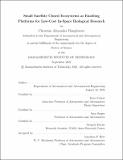| dc.description.abstract | Over the past two decades, the popularity of small spacecraft has taken off, with nearly 200 CubeSats launched in 2019 alone. The objectives for these CubeSats have typically been Earth observation, communication, technology demonstration, or education. Very few CubeSats are launched with biological research payloads, which are typically hosted on larger spacecraft due to the size, weight, and power (SWaP) requirements of these experiments. A closed ecosystem, in which a combination of organisms exist in a symbiotic balance within a environment sealed against mass transfer with the outside world, offers the possibility to conduct long-duration, low-cost biological research on small spacecraft by eliminating the need for consumable supplies, such as food, as well as complex equipment such as feeding robots or waste scrubbers. The motivating mission studied in this work, called SCAMPI (Self Contained Arthropod Module for Permanent Inhabitation), is a 3U CubeSat for demonstration in low Earth orbit (LEO) of the ability to host a closed ecosystem with a volume of 475 millilitres. This work develops novel elements including the mechanical design of the ecosystem container, design of the thermal management system needed to maintain a survivable temperature range, trade study and selection of instruments and components used to monitor and characterize the payload, and evaluation of the economic case for closed ecosystem research as compared with traditional approaches to astrobiological research. | |
